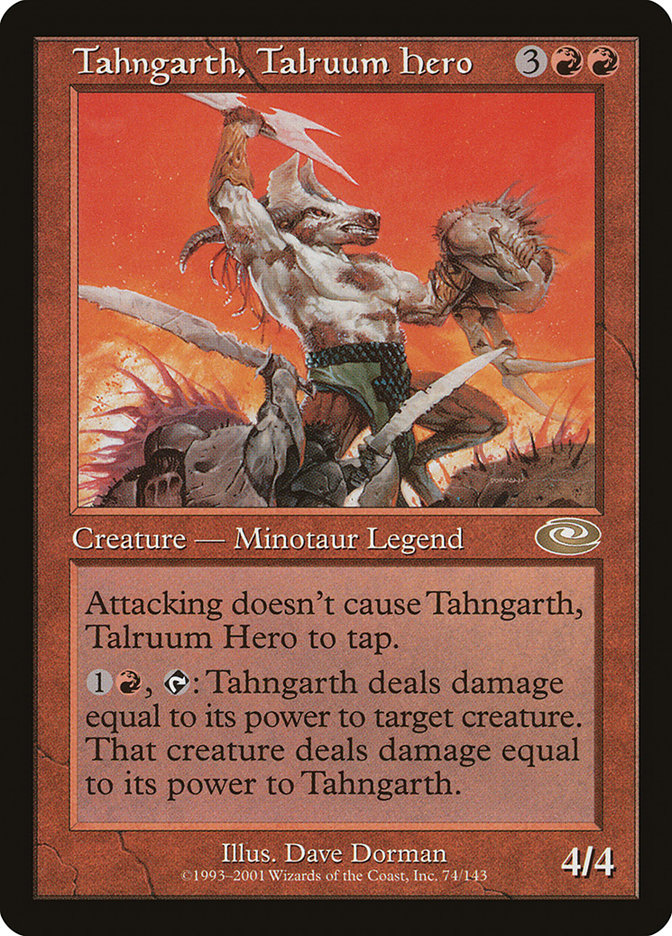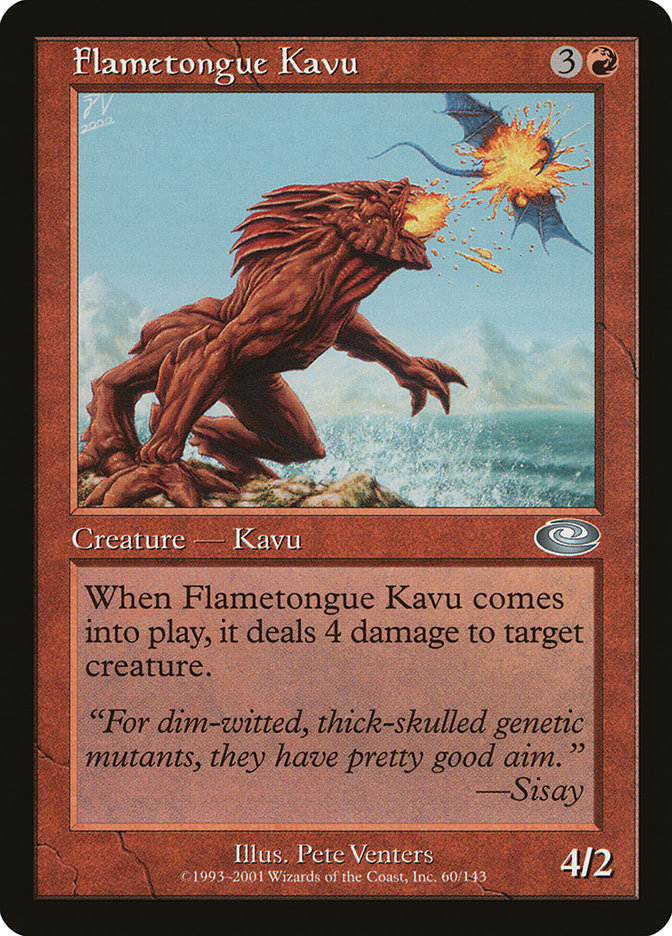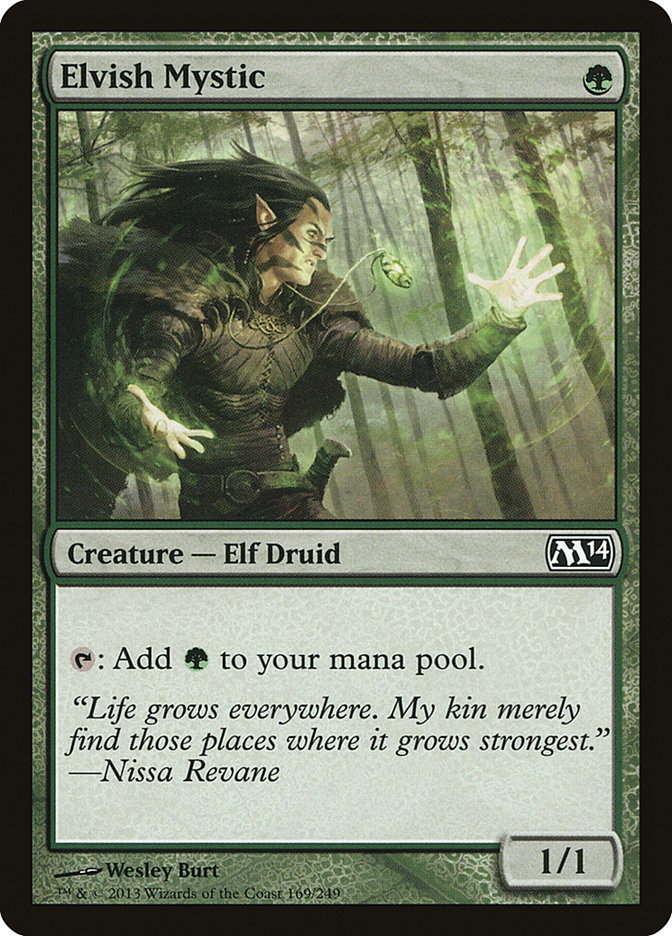The first time that I saw Predator Ooze, I was pretty pumped about it. Predator Ooze, if you don’t already know, is pretty damned awesome.
Now, that being said, it hasn’t dominated Magic by any stretch of the imagination. A card can be awesome and not take things over. Hell, a card can be awesome and not even be played—or at least not played that much.
One of my favorite examples of this is Magic’s coolest Minotaur. Unfortunately for him, he isn’t even Magic’s best Minotaur, but that’s okay.
If Tahngarth had been printed in Invasion, Tahngarth would have been a game-changing card. For the era, it was an efficient creature. The ability of Tahngarth to fight other creatures was incredibly powerful in that moment in Magic. Unfortunately for Tahngarth, he didn’t live outside of the context of all of the other cards in the format. He wasn’t printed in Invasion; he was printed in the next set, Planeshift, and in Planeshift he had to contend with this little bad boy:
It wasn’t that Tahngarth had to compete with Flametongue Kavu for space in a deck that kept it from being played—decks that played Tahngarth could also just played FTK on top of their Tahngarths. The issue was simple: Flametongue Kavu was simply so good that you couldn’t really play any creature that would die to it unless it was cheaper than it.
Flametongue Kavu’s reign was so long lasting that when awesome cards from Magic’s past were reprinted (Serra Angel and Sengir Vampire), they simply couldn’t meet the new bar of entry into the format. Eventually, Flametongue exited the format, but as new creatures were printed that could meet the Flametongue bar, other creatures kept up and Serra and Sengir just faded into the background, relics from another era.
You might think that I’m about to say that Predator Ooze is like Tahngarth in that it just slipped in below the bar and will thus always be outside of the range of reasonable choices for a competitive deck. Actually, though, the major problem with Predator Ooze is not that it isn’t powerful enough but rather that it demands too much of a deck playing it that it’s hard to make a deck that can reasonably cast it and still be a good deck.



That is a huge hurdle. If you’ve tried to cast a Boros Reckoner, you know that sometimes it can be burdensome to cast. Patrick Sullivan, in a great interview for Pro Tour Dragon’s Maze, shared a red deck that splashed green, and yet it also ran a few Temple Gardens. For a lot of people, this would have been mystifying. PSulli’s explanation made it clear: you needed more green for your green splash, but you also needed to cast Boros Reckoner and the white mana at least would help.
Predator Ooze is less forgiving on mana. By far.
Some people tried to make a go of it at the end of last year. Brian Kibler got a little bit of notice for this deck back at the 2012 SCG Invitational in Los Angeles:
Creatures (26)
- 4 Arbor Elf
- 3 Strangleroot Geist
- 4 Predator Ooze
- 2 Wolfir Avenger
- 3 Ulvenwald Tracker
- 3 Dreg Mangler
- 3 Deadbridge Goliath
- 4 Lotleth Troll
Planeswalkers (3)
Lands (23)
Spells (8)

To quote Kibler, “Predator Ooze was an absolute monster.” He decided to forego the limitations of Mono-Green by dipping into black to gain access to not only some very powerful removal but also to make use of the newly printed Lotleth Troll. He did pretty well at that event, but in a case of parallel development, another group of players did quite well with another version of the same concept at a $50K a month earlier. They were actually the talk of that tournament, running a deck that was largely designed by occasional Wisconsin Pro Tour player Lukas Carlson, with many people at the top of the tables and one player in the Top 16. Here is that list:
Creatures (22)
Planeswalkers (5)
Lands (12)
Spells (21)

Both Brian and Lukas made some similar decisions, but one thing that was notable was the decision by both to use Golgari Guildgate. In an aggressive deck, Guildgates are one of the saddest lands that you can run, but that doesn’t mean that you don’t need to do something like that in order to get the mana to work. Kibler actually cut one Guildgate to make room for a single Swamp. What they both agreed on, though, was that they needed a ton of green mana in the deck to even be able to cast the Ooze.
When you plan on playing a card like Predator Ooze, you need to be able to get GGG, and you need to get it quickly. Back before Return to Ravnica bumped some of the good mana out of green, we did see the occasional deck that made great use of Predator Ooze. Take this deck from SCG Standard Open: St Louis, back in 2012:
Creatures (23)
- 3 Llanowar Elves
- 4 Birds of Paradise
- 1 Viridian Corrupter
- 4 Dungrove Elder
- 4 Strangleroot Geist
- 3 Predator Ooze
- 1 Wolfir Silverheart
- 2 Ulvenwald Tracker
- 1 Thragtusk
Lands (24)
- 24 Forest
Spells (13)

I wrote about this deck a long while back, mostly focusing on the awesomeness of Dungrove Elder (may it forever rest in peace). Predator Ooze remained in my builds of the deck, though, because for a lot of opposing aggro decks, it might as well be an impenetrable wall and when you are ready to turn the tables, it’s a monster. Here’s my final version of that list:
Creatures (29)
- 4 Llanowar Elves
- 2 Birds of Paradise
- 4 Elvish Visionary
- 4 Borderland Ranger
- 3 Arbor Elf
- 4 Dungrove Elder
- 4 Strangleroot Geist
- 2 Predator Ooze
- 2 Ulvenwald Tracker
Lands (20)
- 20 Forest
Spells (11)

One of the things that you’ll notice between these two decks: he had seven ways to accelerate into a turn 2 Ooze and I had nine.
This brings me to the missing link for Predator Ooze these last many months: mana. It has simply been too difficult to cast Predator Ooze reliably and quickly enough for a long while. The salvation of the Ooze is simple:
Elvish Mystic might just be a new-fangled Llanowar Elves, but what it also provides is some redundancy with Arbor Elf so that you can up yourself to an eight count of one casting cost green mana producers. Now, this won’t last for very long: once Theros comes out, it is going to kick M13 to the curb. But for now, this is a big deal.
Another thing that comes out of M14 is a rules change that makes a big splash: the M14 planeswalker rules is a huge boon to Garruk Relentless and Garruk, Primal Hunter specifically because both of these cards sometimes are at a terrible loyalty level and the ability to essentially overwrite them is a huge thing. While all planeswalkers get more powerful, planeswalkers that sometimes get a little sluggish because you can’t get rid of them get even more out of the rules change.
On the plane ride back from Patrick Chapin incredible wedding, I was contemplating the influence of Elvish Mystic and planeswalkers, and I realize that all of the pieces are there for there to be a very reasonable, powerful Predator Ooze deck. Immediately, Kalonian Hydra entered the mix as well. The initial build started out with the “obvious” call of four Rancors, but I have been largely influenced by Zvi Mowshowitz claims about two being a great number right now, as you don’t get flooded on it, and I did find myself sometimes stuck on Rancor without a reasonable target.
Here is where I’m currently at:
Creatures (27)
- 2 Acidic Slime
- 4 Arbor Elf
- 3 Scavenging Ooze
- 4 Strangleroot Geist
- 4 Predator Ooze
- 1 Ulvenwald Tracker
- 1 Thragtusk
- 4 Elvish Mystic
- 4 Kalonian Hydra
Planeswalkers (6)
Lands (3)
Spells (24)
- 2 Rancor
- 20 Forest
- 2 Ranger's Guile

I don’t have a sideboard yet, but I’m initially pleased with the way that the deck flows. There are a couple of choices that I’ve made that might have you scratching your heads (other than only two Rancor), so I’ll get into them.
Maybe I’m paranoid, but I’m running three Scavenging Oozes because I still expect there to be a lot of graveyard decks. I don’t want to be smashed by an Unburial Rights. In addition, with all of the tiny little creatures in this deck, having a Scavenging Ooze to come out in a midgame that might have been preceded by the death of many Elves feels good to me.
There are a ton of five-drops in this deck. Between four Kalonian Hydra, two Acidic Slimes, one Thragtusk, and two Garruk, Primal Hunters, that is about seven million five-drops (okay, nine). Despite that, I feel very happy with this combination. One of the things that the deck has is 31 mana sources; another is that with Garruk Relentless you can flip to Garruk the Veil-Cursed and actually want to tutor for Acidic Slime or Thragtusk in order to put different kinds of games out of reach. Big Garruk is just an incredibly powerful card, and I think there is a reason that both Brian and Lukas chose to run several in their decks. Copying success is a recipe for success.
With that being said, another question that often comes to mind in a deck like this is why not run another color. The obvious choice is black to follow in the footsteps of Brian and Lukas. The other option is to bring in red for Domri Rade. I could definitely make this switch and gain access to some powerful cards, but I’m no longer certain that the deck needs it and I like the idea that I can get away with zero Guildgates, a card that would otherwise be a necessity.
In addition, my extensive testing of previous versions of this deck made it clear that I only need about eighteen or so Forests (depending on how many cards like Borderland Ranger and Elvish Visionary are in the mix) to be able to support the inclusion of Cavern of Souls without any regular cost, so I get to have a powerful land with an ability to join in on the fun. I might end up cutting some Forests in the end for Mutavaults.
Ranger’s Guile is also sure to raise some eyebrows, but I feel very good about it. Hell, [author name="Brian Kibler"]Brian Kibler[/author] spent four paragraphs defending Ranger’s Guile in his sideboard, and I came to the exact same conclusion, albeit with first Apostle’s Blessing and then later Ranger’s Guile. Sometimes you just need to defend your Ooze or Hydra from removal. People keep on saying, “Oh, they’ll just kill your Hydra, and then where are you?” Well, what if you “counter” their removal? Stopping Doom Blade or Azorius Charm is pretty sweet.
I’m still working on the details of the sideboard, but the rough list might look something like this:
1 Thragtusk
1 Scavenging Ooze
1 Ranger’s Guile
1 Triumph of Ferocity
2-3 Silklash Spider
x Fog
x Naturalize
I’m pretty pumped for when these cards are released on Magic Online so that I can do more active playing with the cards—right now Magic Online is the primary place where I’m doing my playtesting. The previous version of this deck was a complete blast, and I’m looking forward to doing more with it in the future, even if only during the brief window before Theros. Maybe it will end up that a black or red splash is the way to go, but until I figure that out, I’ll be running it Mono-Green, attacking in with my nine oozes.
Until next time,





